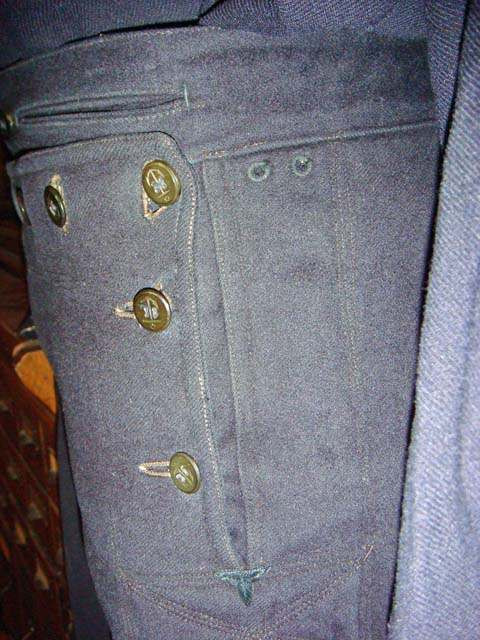The history of the United States Navy uniforms is rich and varied, reflecting the evolving needs and traditions of naval service. Among these, the uniforms worn by enlisted personnel have a particular significance, embodying the everyday sailor and their vital role. An examination of the 1897 regulations provides a detailed glimpse into the specific garments prescribed for these sailors, notably the overshirt and blue trousers. This article delves into the specifics of these uniform items as outlined in the historical documents, shedding light on their construction and features.
Delving into the 1897 US Navy Overshirt
The 1897 regulations meticulously describe the overshirt designed for all enlisted men, excluding chief petty officers, officers’ messmen, and bandsmen. This garment was to be crafted from “dark navy-blue flannel” and designed to be “loose in the body.” A key feature was the double thickness of the back and breast panels, extending “four (4) inches below the line of the shoulder blades” and shaped in a “deep shield.”
The neck opening was specified to extend “downward seven (7) inches” and was designed to be covered by a “detachable breast piece of double thickness.” This breast piece was secured with buttons, featuring “buttonholes in each corner and secured by four (4) corresponding buttons on inside of shirt.” Sleeve circumference was dictated to be between “twenty (20) to twenty-three (23) inches,” sewn to cuffs with “six box or double plaits.”
A distinctive element was the collar, made of “double thickness,” measuring “nine (9) to ten (10) inches deep and from fifteen (15) to eighteen (18) inches long.” The collar’s square corners were to be adorned with “three (3) stripes of white linen tape three-sixteenths ( 1 3/16) of an inch wide and three-sixteenths (3/16) of an inch apart.” These stripes, with specific spacing and placement, extended down to the “bottom of the neck opening.” Furthermore, each corner of the collar was to feature “a plain five-pointed star, three-quarters (3/4) of an inch in diameter, worked in white.”
Cuffs, also of “double thickness” and “three (3) inches deep,” included “wrist slits extending three (3) inches above the upper edge of cuffs.” They were fastened with “two small black navy buttons” and trimmed with white linen tape stripes, the number of stripes varying based on rank: three for petty officers and seaman first class, two for seaman second class, and one for seaman third class. Finally, a practical “small pocket” was to be “let into the left breast” with a straight opening, reinforced with a “crow’s-foot, or diamond point, worked in black silk.”
Understanding the 1897 US Navy Blue Trousers
The regulations also provided detailed specifications for the blue trousers, intended for all enlisted men except chief petty officers, stewards, officers’ cooks, and bandsmen. These trousers were to be made of “dark navy-blue cloth” and designed to “fit snugly over the hip and clown the thigh to two (2) inches above the knee.” Below the knee, they were to be “cut bell-shaped and full enough to be pulled over the thigh.” Each leg was constructed with “one seam on each leg on the inside” and featured a “wide turn-up hem at the bottom.”
The waistband was designed to be “two (2) inches wide in front and one and one-half (1 1/2) inches wide at the back,” fastened in the front with “two (2) buttons.” A notable feature was the “gusset at center of back,” allowing for adjustability. The flap, “six and one-half (6 1/2) inches deep,” had “eleven (11) buttonholes around the sides and upper edge.” Pockets were included “in waistband on each side,” and “small black navy buttons” were to be used throughout.
 Detail of US Navy enlisted trousers from 1897 regulations showing eyelets and crow's foot stitching
Detail of US Navy enlisted trousers from 1897 regulations showing eyelets and crow's foot stitching
Details like the “small sewn eyelets” for drying lines and the “black silk ‘crow’s foot'” reinforcement, as highlighted in existing uniforms, corroborate the precision of these 1897 regulations.
Significance of the 1897 Regulations
The 1897 regulations offer a valuable window into the specific details of Us Navy Enlisted Uniforms during that era. These meticulous descriptions illustrate the standards of uniform construction and the distinctions in rank reflected in the garment details. Studying these historical uniform regulations provides a deeper appreciation for the heritage and evolution of US Navy attire.
For a more comprehensive understanding, the full 1897 regulations are available online, offering further insight into the broader context of naval uniforms of the time: http://www.quarterdeck.org/uniforms/1897/21-37%20Enlisted%201897.htm
